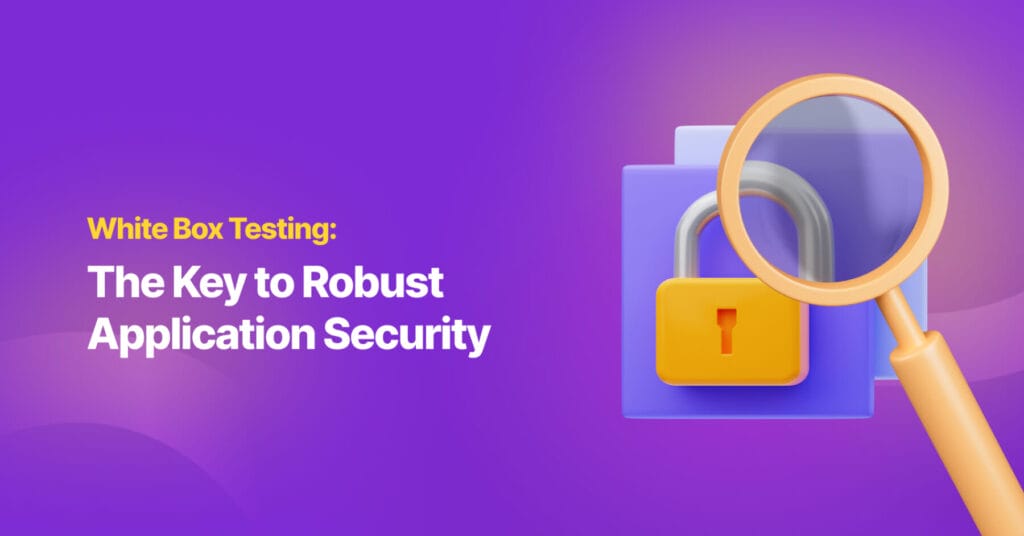As cyber threats emerge daily, developers and security specialists must safeguard their programs against attack. Today’s digital world relies totally on application security.
White box testing delves deeply into the code to identify faults that may not be evident from the outside, as opposed to black box testing, which involves the tester interacting with the software from the end user’s perspective. White box testing, or software testing performed by someone who understands how the application works, is a highly efficient method of preventing security breaches. This blog discusses the importance of white box testing, the tools and methodologies utilized, and typical security flaws in systems.
White box testing, also known as clear box, glass box, or structural testing, requires the tester to have a complete understanding of the application’s internal operations. This methodology enables the identification of logical mistakes, security flaws, and other problems that external testing could miss.
Take a banking app that manages transactions, for instance. A black-box tester can verify whether the transaction was successful. On the other hand, a white-box tester would investigate the underlying code to ensure that no “bad actors” could take advantage of any security flaws. They may discover weaknesses allowing SQL injection attacks or other cyber threats, such as incorrect input validation.
The Importance of White Box Testing
White box testing, also known as clear box testing, structural testing, or code-based testing, is important for several reasons:
- Thorough Vulnerability Detection: White box testing, which examines the internal structure, logic, and code design, can discover vulnerabilities that are not detectable through exterior testing. This comprehensive method ensures that even the most obscure issues can be identified.
- Early Bug Detection: Integrating white box testing into the development process enables early detection and resolution of errors, lowering the cost and labor of resolving issues later.
- Improved Code Quality: Knowing their work would be closely examined internally motivates engineers to build cleaner, more maintainable code through regular white box testing.
- Enhanced Security: By thoroughly understanding the code’s functionality, testers can replicate complex attack routes that are more in line with actual hacking tactics.
Steps to perform White Box Security Testing:
Information Gathering
At this stage, we focus on gathering all information about the target application. This executed meetings with developers to discuss the application, its features, and functionalities. During these sessions, we receive credentials and source code, and we go over the application’s logic flow. Most of the information comes directly from the product owner rather than from external sources. We also finalized the scope of penetration testing. For example, if we want to do white box security testing in the Web Application, we need to consider the env machine, network, security system, etc, that is included in the testing scope.
Scanning & Discovery
In this stage, for the first time, we are using automated tools to scan all source code to find bad implementation or security holes. We can use some automated tools such as SonarQube, Fortify Static Code Analyzer, and Checkmarx to help in code analysis by identifying patterns that lead to potential vulnerabilities, such as buffer overflows and SQL injections. In addition, linters that ensure code adheres to certain coding standards and identify errors that can lead to vulnerabilities include Pylint for Python and ESLint for JavaScript.
While waiting for the scanner to complete its work, we can also do further inspection by manually reviewing the code related to the application’s business logic or one of its features. However, this requires deeper and longer experience and knowledge in application development, and we must master the programming language used for application development.
Vulnerability Analysis
Following data collection via various methods, we can search for vulnerabilities that are known to the public and could be exploited to gain access to the target. We can use scanner tools to help us find vulnerabilities and automatically add CVE or CWE information for each finding if the tool finds any potential vulnerability.
In the manual testing, we need to put a CWE score based on the deep impact of the vulnerability. We can use Common Weakness Scoring System to score for each manual finding. For a more detailed finding analysis, we can use CWSS V1.0.1 from this link to identify CWE https://cwe.mitre.org/cwss/cwss_v1.0.1.html. On the other hand, for the CWE score or CVE score based on the scanner tools, we need to revalidate the finding to be a true positive or a true negative.
Commonly used Tools
White box testing frequently uses several tools and frameworks to guarantee a comprehensive software analysis:
- Static Application Security Testing (SAST): Tools like SonarQube (inspects your code quality continuously, detecting bugs and vulnerabilities across various programming languages), Snyk (find and fix vulnerabilities in your open-source dependencies and monitors your projects for new threats), and Checkmarx (scans your code for security flaws, compliance issues, and coding errors, providing detailed reports and recommendations) scan built or source code for security vulnerabilities.
- Dynamic Application Security Testing (DAST): Tools like Burp Suite and OWASP ZAP can be configured for white box testing by providing additional code context, even if they are more commonly used for black box testing.
Manual Code Review
While automated tools like static analysis scanners (SAST) are great at detecting many common vulnerabilities, they are only the first step in white-box testing. The real power of white-box testing comes from the manual process that follows. And this requires the skills of someone who already has the skills to implement secure code. Key Manual Steps After Automated Testing:
- Code Review: we need to go beyond tool detection. Conduct manual code reviews to find complex logic errors, backdoors, or security misconfigurations that tools may have missed.
- Peer Review: we can bring in developers or security experts to conduct code reviews. Peer reviews can often provide new perspectives and uncover vulnerabilities that our tools have overlooked.
- Threat Modelling: After we have conducted manual code reviews, we can then conduct threat modeling. This helps us identify the various ways an attacker could exploit weaknesses in our code and system design.
By combining automated tools with manual reviews, white-box testers can uncover a range of issues, from easily solvable problems to more detailed vulnerabilities.
Scoring Vulnerabilities – Prioritizing Risk Using CWE
CWE (Common Weakness Enumeration) can be used to classify software and hardware vulnerabilities and can also be leveraged to help prioritize risks by using built-in CWE Weakness Severity Ratings or aligning them with internal severity thresholds.
How to Use CWE for Prioritization:
- Utilize the Impact and Frequency of CWE Weaknesses:
CWE already categorizes the impact level of a finding (Low, Medium, or High) for different types of vulnerabilities, indicating the level of the vulnerability in terms of potential consequences.
CWE also provides a “General Severity Rating” for a given vulnerability, which helps determine how significant the vulnerability is in a real-world scenario.
For example, CWE-89 (SQL Injection) is categorized as a High Impact finding due to its ability to compromise the confidentiality, integrity, and availability of an application.
- Identify Frequently Exploited Vulnerabilities
CWE also tracks which vulnerabilities are most frequently exploited by attackers. This information can be vital in prioritizing vulnerabilities that are not only theoretically dangerous but are also known to be widely exploited.
For example, CWE-79 (Cross-Site Scripting) is a commonly exploited vulnerability, so remediation of even a medium-severity XSS issue can be prioritized because of its widespread exploitation.
- Consider the CWE “Attack Surface” Attribute
Some CWEs will guide us through potential attack surfaces exposed by a vulnerability, which could allow an attacker to easily access and exploit the vulnerability. Vulnerabilities with a larger attack surface (e.g., accessible to untrusted users via the web) should be prioritized.
Example: If a vulnerability impacts an externally facing service or involves validating user input (such as CWE-20, Input Validation), it should be prioritized over internal-only vulnerabilities.
- Use CWE Categories and Views:
CWEs categorize vulnerabilities into larger “views” such as the CWE/SANS Top 25 Most Dangerous Software Flaws, which highlights the most critical and dangerous vulnerabilities. Vulnerabilities listed here should be given higher priority.
Example: Vulnerabilities in the CWE-Top 25 (e.g., CWE-79, CWE-89) should be considered high priority.
- Map CWEs to Internal or External Standards
Many organizations map CWEs to existing risk management frameworks or internal security policies to create a custom prioritization matrix. For example, some organizations may align CWEs to OWASP or ISO 27001 standards to prioritize vulnerabilities.
Example: If your organization uses a custom severity scale (Critical, High, Medium, Low), you can map relevant CWE types to these categories based on their potential impact and exploitability.
Prioritization Workflow with CWE:
Here’s a basic workflow to prioritize vulnerabilities using CWE:
Step 1: Classify the vulnerability using CWE – Assign each discovered vulnerability a CWE identifier based on the weakness.
Example: A SQL injection flaw is assigned CWE-89.
Step 2: Look at the “Typical Severity” and “Impact” levels from CWE to understand the potential business impact.
Example: CWE-89 is marked as High Impact, meaning it’s a serious issue.
Step 3: Check how often the vulnerability is exploited. If it’s a common target, it should be prioritized higher.
Example: CWE-79 (Cross-Site Scripting) is frequently exploited, so it should be a high priority even if its severity is medium.
Step 4: Consider the attack surface and context. Vulnerabilities in high-risk areas, like user inputs or external APIs, should be prioritized.
Example: CWE-20 (Improper Input Validation) on an external-facing web service is a high-priority issue.
Step 5: Align CWE with your organization’s policies or industry standards to refine prioritization.
Example: Your company might classify CWE-89 (SQL Injection) as a Critical vulnerability, requiring immediate action.
The Unknown: Persistent Challenges
White box testing has advantages, but there are also several difficulties:
- Complexity and Expertise: A thorough grasp of the code and its operating environment is necessary for white box testing. This can be a significant resource limitation as it calls for knowledgeable testers who can navigate intricate codebases.
- Dynamic and Evolving Code: Microservices, fast code changes, and third-party service integrations are standard features of modern apps. Staying current with these changes while maintaining comprehensive white box testing coverage is challenging.
- False Positives and Negatives: Even the most advanced tools may produce false negatives, which conceal vulnerabilities, or false positives, which squander time. Fine-tuning these tools to reduce errors takes a lot of work.
- Integration with Development Pipelines: It may be challenging to ensure that white box testing tools are seamlessly integrated into continuous integration/continuous deployment (CI/CD) pipelines, mainly when dealing with outdated systems or heterogeneous tech stacks.
Addressing the Challenges
A variety of tactics may be used to address these obstacles:
- Education and Training:
To improve their capabilities, developers and testers must consistently upgrade their skills with the latest technologies. - Automation:
Applications can be made more accessible and less complex if we use automation in testing - Continuous Monitoring:
We can use CI/CD procedures to ensure that newly discovered vulnerabilities are quickly found and fixed during development. - Collaboration:
Collaboration between development, operations, and security (DevSecOps) teams to ensure security is a shared responsibility,
Conclusion
Whitebox security testing is more than just running automated tools – it’s about really understanding the application’s inner workings, applying secure coding standards, and systematically identifying and scoring vulnerabilities. Tools and techniques are just part of the process; the real challenge is in how we prioritize and fix the issues we find. By using frameworks like CWE (Common Weakness Enumeration), testers can better categorize weaknesses, which helps developers understand the root causes of vulnerabilities. On the other hand, frameworks like CVSS (Common Vulnerability Scoring System) help prioritize these weaknesses based on real-world risk.
A successful Whitebox security test does more than just spot vulnerabilities. It empowers development teams to create more secure software by providing structured feedback, applying industry-standard practices (like using CWE for classification), and offering actionable insights. When security and development teams regularly collaborate, it ensures a proactive approach to securing applications from the inside out.
So, the next time you conduct a Whitebox security test, remember that the goal is not just to find weaknesses but also to equip teams with the knowledge and processes—like CWE and CVSS—that foster a culture of continuous improvement in secure coding practices and software development.






